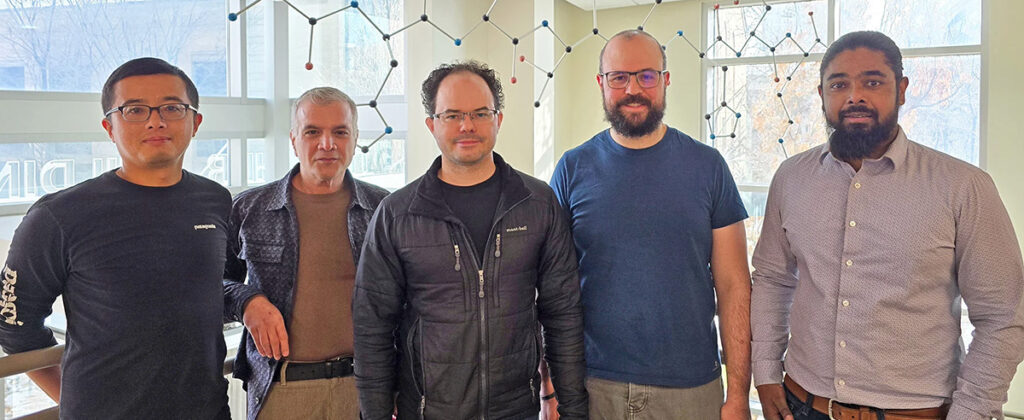Note: This story originally appeared on the Technology Licensing Office’s website.
Imagine a world where once “undruggable” diseases—like certain cancers and genetic disorders— can finally have a new treatment. Sethera Therapeutics is working to make this world a reality, addressing the unmet need for effective treatments in conditions that have previously had no therapeutic options.
Peptides are powerful small, flexible chains of amino acids with incredible potential to treat diseases. However, these molecules often need to fold into precise shapes to function properly—much like a key fitting into a lock. The challenge? Peptides are naturally unstable and break down quickly, limiting their effectiveness as drugs. Sethera Therapeutics has been able to bioengineer peptides to become highly stable, controllable bonds, addressing their natural tendency to degrade quickly. This innovation has enabled several major advancements in peptide-based medicine:
1. Unlocking Treatments for “Undruggable” Diseases
Many diseases remain untreatable due to the lack of effective therapies. Today’s traditional drugs cannot effectively interact with their molecular targets. However, Sethera’s technology could change that, expanding the possibilities for treating conditions once considered undruggable.
Vahe Bandarian, co-founder and University of Utah associate dean, highlights this potential, stating, “The exciting thing about our technology is that it isn’t limited to a single disease—it has the potential to improve virtually any peptide-based therapeutic.”
2. Oral Medication and Longer Lasting Treatments
Currently, many GLP-1 medications used for diabetes and weight management require frequent dosing—sometimes daily or weekly. Additionally, most peptide drugs must be injected as they break down in the digestive system before taking effect. By enhancing peptide stability, Sethera’s innovation could offer longer-lasting treatments, reduce dosing frequency, and open the door for oral alternatives. This is a game-changer for patient adherence, improving both the quality of life and treatment outcomes for patients who currently struggle with the burden of frequent injections.
Karsten Easton, Co-founder and CEO of Sethera, said, “Imagine taking your GLP-1 medication just once a month.”
Bandarian, expanded with “If the patient doesn’t have to inject once a week, but maybe twice a month, compliance issues become much easier to manage.”
Sethera’s breakthrough technology has the potential of revolutionizing treatment options for a wide range of conditions. Offering hope and new possibilities to patients who previously had limited to no treatment options.
The Minds Behind Sethera
Sethera Therapeutics was co-founded by Karsten Eastman and Vahe Bandarian, two experts in the field whose expertise and collaboration are driving a new era in peptide-based medicine.
Karsten Eastman, now serving as CEO, earned his PhD in chemistry from the University of Utah, where he specialized in enzyme and peptide research under the mentorship of Vahe Bandarian. Bandarian is a distinguished faculty member, associate dean at the University of Utah, and Sethera’s Chief Science Officer (CSO).

From the start, Bandarian prioritized mentorship, ensuring that Eastman’s academic foundation remained strong while Sethera’s commercialization potential was explored. His guidance focused on science first, emphasizing the importance of completing Eastman’s dissertation and publishing research papers before delving into commercialization. “That way, no matter what happened with the company, he had options,” Bandarian explained.
Why Sethera’s Technology Matters
Sethera Therapeutics’ work has the potential to revolutionize the treatment of diseases that have long been considered untreatable. Their ability to stabilize peptides opens the door for a new era of therapeutics that can target a broader range of diseases more effectively, with fewer side effects. By making these treatments more stable and easier to administer, Sethera is not only addressing a major unmet need in healthcare but also improving patient adherence and outcomes. The broader impact of this technology could transform the future of medicine—making life-saving treatments more accessible, reducing healthcare costs, and offering patients a better quality of life.
The Future for Sethera
As for what is next for Sethera, Easton wishes to partner with pharmaceuticals companies. He mentioned, “We have technology and we can generate the libraries. We want to know what are the interesting targets that they want to hit.”
By partnering with industry leaders, Sethera hopes to bridge the gap between cutting-edge peptide discovery and real-world therapeutic applications. This collaborative approach can ensure Sethera’s technology reaches the front lines of healthcare, treating conditions once deemed untreatable and improving patient care.
Sethera’s rapid growth has been fueled by key milestones, including a recent $3 million funding round and the addition of great new hires as well as biotech pioneer Dr. Robert Langer—co-founder of Moderna—as chair of their scientific advisory board. With these key milestones, the company is well positioned for even greater breakthroughs.
Eastman explains the next strategic milestones:
- Developing screening technology to enhance the efficiency and accuracy of disease diagnosis.
- Stabilizing previous unstable peptides into viable drugs by improving their stability.
- Collaborating with pharmaceutical companies to develop new therapeutics for rare diseases.
Collaboration with The U of U
Sethera’s success has been fueled by collaboration. For example, Eastman highlighted how the University of Utah’s Chemistry Department helped facilitate their research by providing lab space through a contract agreement. This has not only supported their scientific progress but has also kept them connected to the University’s broader innovation ecosystem.
Eastman credits the Technology and Licensing Office (TLO) and University of Utah Ventures for playing a critical role in transforming their academic discovery into a thriving startup.
As he explained, “The TLO was instrumental in ensuring that from the initial disclosure to the internationalization of the patent, it all went as smoothly as possible.” Following this, Jim Hotaling, head of the Utah Venture Hub, helped Sethera take its next steps by making key introductions that supported their early growth.
Advice for Innovators
When asked about Sethera’s journey, Eastman offers advice for fellow researchers and startups. He emphasized the value of experimentation, stating, “It’s okay to do things you think might not work just to see the result.” He shared that he pursued a project despite doubts, which ultimately led to Sethera’s breakthrough. He also encouraged questioning research publications, suggesting that trying a slightly different approach can yield unexpectedly successful results.
As for startups, Eastman advised, “Try to do as much as you can before the company starts.” He stressed the importance of building a strong foundation, explaining that while he’s no longer in the lab daily, the groundwork he laid early on has allowed Sethera to progress rapidly.
With partnerships forming and their technology rapidly advancing, Sethera is turning what once seemed impossible into reality!

